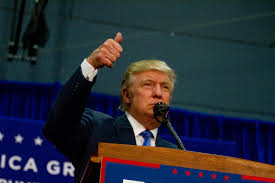The poor performance in 2016 is due in large part to the growing trade deficit, the decline in U.S. exports and increase in imports, according to the Bureau of Economic Analysis. And while consumer spending got credit for driving growth, it was not enough to keep the economy at pace. Neither was the growth in the housing market or corporate profits.
In real GDP growth, the numbers are even worse. Adjusted for inflation, the U.S. economy grew only 1.6 percent in 2016.
Donald Trump ran his campaign promising to turn the U.S. economy around and regularly attacked his predecessor, Barack Obama, for overseeing the weakest recovery in U.S. history.
On the new White House website, President Trump repeated his campaign promise to reach 4 percent annual economic growth, rates that haven’t been seen since 2000. He outlined a “bold plan” consisting of three steps: tax reforms that slash corporate tax rates, cutting federal regulations and negotiating or renegotiating trade deals with America’s foreign partners.
In step with his growth plan, Trump said he intends to put the country on track to create 25 million jobs by 2027. To keep on pace with that promise, the American people should expect Trump to create 10 million jobs by the end of his first term in office. That level of job growth is certainly not impossible. According to the Bureau of Labor Statistics, more than 10 million jobs were added during Obama’s second term in office, 10.7 million during Ronald Reagan’s second term, and Bill Clinton averaged 11.8 million new jobs across his two terms.
Donald Marron, director of economic policy initiatives at the Urban Institute insisted that Trump’s call for consistent 4 percent growth “is a very, very heavy lift.” In order to get there, he recommended focusing on two key factors. “We’d need faster productivity growth and rapid growth in the labor force.”
The unemployment rate has declined sharply from its 2010 height of 9.6 percent, down to 4.9 percent today, very close to full employment. Adding millions more jobs would help boost domestic production and spur economic growth, but Marron questions whether the American workforce is even large enough to achieve that.
“Trump needs millions of Americans who have left the labor force (and thus aren’t counted as unemployed) to come back in and get jobs. And for millions more Americans to stay working longer,” Marron explained. “Not impossible, but unlikely.”
Another option, he suggested, is Trump could accelerate immigration to expand the labor force, “but that appears off the table.”
In recent days Trump has focused on reducing the U.S. trade deficit, an effort that took an unconventional turn on Thursday.
During an address to Republican lawmakers at their annual retreat on Thursday, Trump outlined a plan to level the playing field with America’s southern neighbor, renegotiate the trade deal to reduce the deficit, and impose a tax on Mexican imports that will pay for his proposed border wall.
“We’re working on a tax reform bill that will reduce out trade deficits, increase American exports and will generate revenue from Mexico that will pay for the wall, if we decide to go that route,” Trump said at a Republican retreat in Philadelphia.
After Trump spoke, White House press secretary Sean Spicer explained the proposal in slightly more depth saying the president is considering a 20 percent border tax on all goods coming in to the United States from Mexico. The tax would pay for the proposed border wall and also cut down on Mexican imports, theoretically stabilizing the trade imbalance. The measure has also been discussed as a way to deter American companies from setting up shop overseas and trying to import goods back to the U.S. market.
Trump’s proposed border tax raised concerns among some Republicans at the retreat, including long-time Trump critic, Sen. Lindsey Graham (R-S.C.). In a series of tweets, Graham referred to Trump’s 20 percent tariff on Mexico as “Mucho Sad,” saying that the step will be a major barrier to growth. “Any tariff we can levy they can levy,” he warned.
There is no doubt that U.S. imports from Mexico have skyrocketed since NAFTA was signed in 1994, and exports have not kept pace. But according to Barry Bosworth, senior economic fellow at the Brookings Institution, new trade restrictions are more likely to lead to a decrease in U.S. economic growth.
Such restrictions “penalize the U.S. best-performing companies—exporters,” while rewarding competing importers, “which are usually the ones who could not succeed in a competitive global economy,” he said.
Additionally, imposing a tariff on Mexico, America’s third largest trading partner, would more likely backfire against American companies and consumers in the form of higher prices for the same goods and services.
According to Department of Agriculture statistics, the United States imported $21 billion in food and drinks from Mexico in 2015. For wine and beer (including Corona), the U.S. imports were $2.7 billion, which means if the Trump tariff were in place, the cost of those goods would increase by $54 million.
Automakers like Ford, General Motors, and Fiat Chysler, who have assembly plants across the border in Mexico would be hit even harder. Bloomberg Intelligence analyst Caitlin Webber crunched the numbers, estimating U.S. losses if the tariff went into place. “If all imports in the first 11 months of 2016 had been charged a 20 percent duty, U.S. importers would have paid about $54 billion in tariffs,” she said.
On Tuesday, Trump sat down with those Big Three automakers at the White House, but according to reports he did not discuss the border tax which is a big concern for the auto industry.
Another step the administration could take to reduce the trade deficit and affect economic growth would be to go after China for keeping its currency value artificially low. The argument is that a stronger Yuan could help ween American importers off of Chinese goods, which would become more expensive. It may also help open the Chinese market to competition with American exports, which in turn could help eat away at the $319 billion U.S. trade deficit with China.
Going after Chinese currency manipulation was one of the top promises Trump made to his supporters when he vowed back in October that on his first day in office he would “direct my Secretary of the Treasury to label China a currency manipulator.”
Earlier this week, Senate Democratic leader Chuck Schumer went after Trump for not making good on his campaign promise. Schumer told reporters, “Mr. President: if you really want to put America first, label China a currency manipulator.” Schumer and other Democrats have been instrumental in stalling a vote on Trump’s pick to lead the Treasury Department, former Goldman Sachs partner Steven Mnuchin.
Another way to get the country out of its sluggish growth rate is to increase productivity overall, Bosworth noted. The average productivity of the American worker has declined in recent decades and remained below 2 percent since 2005.
“The key to doing better is to improve productivity. Increases in capital per worker are one way to do that and higher investment is an objective of the tax cut. More important would be to raise the rate if innovation,” Bosworth said. He continued that “infrastructure investment, improved education and more [research and development] could raise future growth.”
Trump has proposed a $1 trillion investment to rebuild America’s crumbling roads, bridges, airports, and other economic infrastructure, but the details of the plan and level of cooperation he can expect from members of his own party remain sketchy at best.
Bosworth’s overall assessment of Trump’s 4 percent growth plan was not optimistic; he said it is “very unlikely on a sustained basis.”
Despite new numbers showing the continued slow economic recovery, after only one week in office corporate America has given Trump a big vote of confidence. Anticipating the new president will succeed with his economic agenda, the Dow Jones Industrial Average hit 20,000 for the first time ever and the S&P 500 hit an all-time high. Whether this market confidence will translate into real economic growth is another matter.






